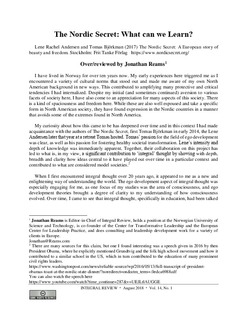| dc.contributor.author | Reams, Jonathan | |
| dc.date.accessioned | 2019-09-03T06:41:02Z | |
| dc.date.available | 2019-09-03T06:41:02Z | |
| dc.date.created | 2018-11-10T12:30:08Z | |
| dc.date.issued | 2018 | |
| dc.identifier.citation | Integral Review. 2018, 14 (1), 311-329. | nb_NO |
| dc.identifier.issn | 1553-3069 | |
| dc.identifier.uri | http://hdl.handle.net/11250/2612115 | |
| dc.description.abstract | I have lived in Norway for over ten years now. My early experiences here triggered me as I encountered a variety of cultural norms that stood out and made me aware of my own North American background in new ways. This contributed to amplifying many protective and critical tendencies I had internalized. Despite my initial (and sometimes continued) aversion to various facets of society here, I have also come to an appreciation for many aspects of this society. There is a kind of spaciousness and freedom here. While these are also well espoused and take a specific form in North American society, they have found expression in the Nordic countries in a manner that avoids some of the extremes found in North America.
My curiosity about how this came to be has deepened over time and in this context I had made acquaintance with the authors of The Nordic Secret, first Tomas Björkman in early 2014, the Lene Andersen later that year at a retreat Tomas hosted. Tomas’ passion for the field of ego development was clear, as well as his passion for fostering healthy societal transformation. Lene’s intensity and depth of knowledge was immediately apparent. Together, their collaboration on this project has led to what is, in my view, a significant contribution to ‘integral’ thought by showing with depth, breadth and clarity how ideas central to it have played out over time in a particular context and contributed to what are considered model societies.2
When I first encountered integral thought over 20 years ago, it appeared to me as a new and enlightening way of understanding the world. The ego development aspect of integral thought was especially engaging for me, as one focus of my studies was the area of consciousness, and ego development theories brought a degree of clarity to my understanding of how consciousness evolved. Over time, I came to see that integral thought, specifically in education, had been talked. | nb_NO |
| dc.language.iso | eng | nb_NO |
| dc.publisher | Arina | nb_NO |
| dc.rights | Attribution-NonCommercial-NoDerivatives 4.0 Internasjonal | * |
| dc.rights.uri | http://creativecommons.org/licenses/by-nc-nd/4.0/deed.no | * |
| dc.title | The Nordic Secret: What can we learn? | nb_NO |
| dc.type | Journal article | nb_NO |
| dc.type | Peer reviewed | nb_NO |
| dc.description.version | publishedVersion | nb_NO |
| dc.source.pagenumber | 311-329 | nb_NO |
| dc.source.volume | 14 | nb_NO |
| dc.source.journal | Integral Review | nb_NO |
| dc.source.issue | 1 | nb_NO |
| dc.identifier.cristin | 1628936 | |
| dc.description.localcode | Open Access CC-BY-NC-ND. The publication of all articles are licensed under the Creative Commons copyright license 4.0. Authors publishing in IR are free to share, copy and redistribute their works under the terms of the Creative Commons license, in that; appropriate credit must be given to IR as the place of original publication, the work(s) may not be used for commercial purposes, and may not be used for derivative work. | nb_NO |
| cristin.unitcode | 194,67,70,0 | |
| cristin.unitname | Institutt for pedagogikk og livslang læring | |
| cristin.ispublished | true | |
| cristin.fulltext | original | |
| cristin.qualitycode | 1 | |

